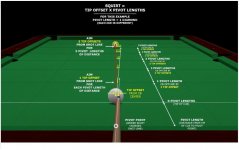I assume that deflection starts when the cue hits the cue ball anyplace other than the direct center of the cue ball horizontal line. It is my understanding that speed has almost untestable effect on the amount of deflection.
Now my question is: Does deflection increase based on how far off center the cue tip hits the cue ball? Is there a rule of thumb on the amount?
Now my question is: Does deflection increase based on how far off center the cue tip hits the cue ball? Is there a rule of thumb on the amount?
